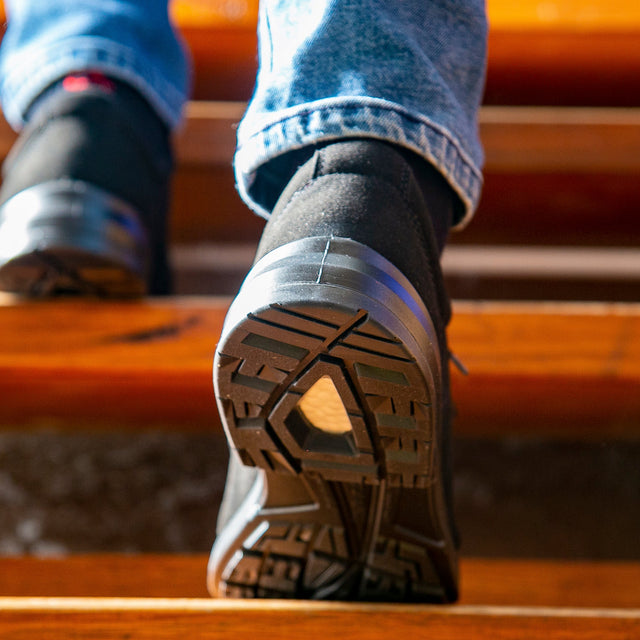Soles For Slip Resistant & Comfy Work Boots And Shoes
A key criterion for the safety and well-being a work shoe or work boot offers to its wearer is the quality of the outer sole. Material, tread depth and tread design must be suited for the respective areas of application. Numerous variants are possible and depend on the particularities and specific conditions of a workplace. We help you to find the right sole so that you are perfectly equipped for your work.
TREAD DESIGN
An ergonomic tread rib configuration ensures improved rolling of the feet and prevents fatigue. Rounded tread edges ensure a safe footing on the ground with less risk for slipping and tripping at work.

TREAD DEPTH
Sufficient height of the tread profile and individual tread bars is particularly important on uneven surfaces. Deep treads deliver superb grip. Self-cleaning characteristics are also important to avoid accidents caused by dirt sticking in the treads.

TYPE OF SOLES - MONO VS DOUBLE DENSITY
The major benefit of double-layered soles is that two different materials can be used.
For example, the outsole can be produced from rubber and the midsole from PU. This combines the advantages of both materials: The superb heat resistance of rubber and the comfortable impact absorption properties of PU.
By contrast, the advantage of a single-layered sole lies in the fact that a single material can be injected with a lower density. This results in a lightweight sole, which adjusts well to different ground and floor conditions.

Double-layered sole

Single-layered sole
RUBBER - for robust and heat-resistant work boots
Rubber outsoles are exceptionally sturdy: short-term temperature-resistant up to 300°C, tough to penetrate by sharp-edged objects and resistant to fuel, oil, microbes and numerous chemicals. Special manufacturing processes make them abrasion-resistant. However, rubber is heavier than PU and TPU, and is somewhat less flexible at cold temperatures.
POLYURETHANE (PU) - for flexible and sturdy safety boots
PU outsoles can withstand temperatures of up to 130˚C and are flexible at temperatures down to -30˚C. Similarly to rubber soles, they are resistant to oil and fuel, numerous chemicals and microbes, and are abrasion-resistant, although they are much lighter. A particular advantage of the material: the good impact absorption characteristics, resulting in improved cushioning and wearing comfort.
THERMOPLASTIC POLYURETHANE (TPU) - extremely abrasion-resistant work boots
The characteristics of TPU outsoles are comparable to those of PU. But they are even more efficient as a result of a special manufacturing process. With enhanced abrasion-resistance they are even more durable, and also their non-slip properties are stronger. Another advantage of TPU outsoles is their higher elasticity and resistance to the cold.
WELLMAXX - revolutionary cushioning material provides maximum comfort on hard ground

01 BEVELLED PROFILE RIBS Particularly good grip on uneven ground. Increased stability and exceptional non-slip properties made possible by tread ribs, which are bevelled in the stopping or push-off direction. This makes the safety shoe highly versatile in every weather and on any surface.
02 ERGONOMIC ROLLING An S-line runs through the entire outsole tread and supports the natural rolling action of the foot: Setting the heel down on the outer edge, rolling over the mid-foot in the direction of the ball of the foot – a movement that precisely follows an S-line.
03 FLEX GROOVES facilitate improved physiological rolling of the foot and easier physiological bending during kneeling activities.
04 LIMITING THE RISK OF STUMBLING AND TWISTING Both ends of the sole exhibit a negative profile, which prevents „sticking“, in particular with turning movements and when setting the foot down.
05 SOLE CORE MADE OF INFINERGY® FROM BASF Cushions impacts and bounces back into its original shape extremely well when the pressure is being reduced, thus the energy is transferred back to the wearer.
06 HONEYCOMB Increased slip resistance on smooth industrial floors. These ensure good slip resistance and optimum stability when standing.

